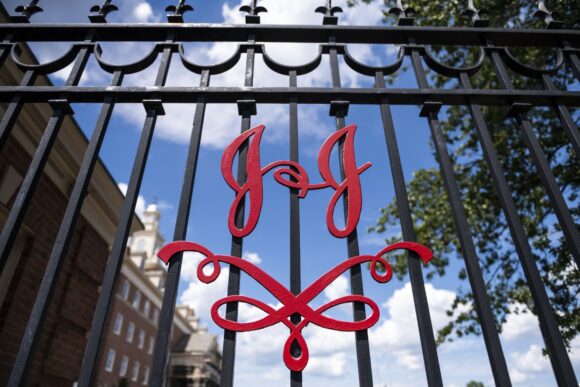The controversial Johnson & Johnson bankruptcy strategy that’s drawn the ire of Congress faces a fresh trial this week, with the consumer products giant arguing that settling billions of dollars of talc liabilities in a single case is better for cancer victims than fighting thousands of individual claims.
J&J begins a week-long court hearing Monday to decide whether it wrongly manipulated the bankruptcy system by putting a unit into Chapter 11 solely to force a negotiated end to more than 38,000 lawsuits. The case has come under fire from advocates for people harmed by corporate malfeasance and in Congress, where legislation is being considered that would ban the company’s tactics.
“This model of Chapter 11 cannot be what Congress had in mind when it enacted” the federal bankruptcy code, bankruptcy attorney Laura Davis Jones told the judge overseeing the hearing as it began in Trenton, New Jersey, a 25-mile drive from J&J’s corporate headquarters in New Brunswick.
The core of J&J’s argument is that bankruptcy was a legitimate option because traditional jury trials are unfair to both victims and corporations. Nearly all of J&J’s alleged cancer victims disagree and their lawyers have filed motions seeking to dismiss the bankruptcy case. One group in Canada, however, took the company’s side.
“The motions raise the ultimate question of when a stampede to the courthouse, and piecemeal litigation, has ever led to a better result for all creditors than that which could be obtained before a bankruptcy court,” wrote lawyers for a class-action lawsuit against J&J in Canada.
Should J&J lose, victims would be free to resume jury trials, potentially exposing the company to billions in additional payouts. In the last five years, J&J spent $4.5 billion to resolve talc claims, according to court papers. Although the company won many trials, there have been spectacular losses. Last year, about 20 people split $2.24 billion after a jury agreed that their cancers were caused by J&J’s talc products, including its iconic baby powder.
Two-Step
After repeatedly vowing to fight all baby powder lawsuits one at a time around the country, J&J adopted the so-called Texas Two-Step strategy last year, partly in reaction to the $2.24 billion verdict, the company said in a court filing.
The company used a business-friendly Texas law to create a new unit, LTL Management, to hold all its talc-related liabilities. LTL then filed for bankruptcy backed by a promise from J&J to pay at least $2 billion to end all current and future baby powder suits.
Under the Texas Two-Step, a small unit is set up to funnel all lawsuits into bankruptcy, allowing the parent company to benefit without having to put itself under court supervision.
Victim advocates point out that J&J is one of the biggest, most profitable companies in the world. As of Friday it was worth $444 billion. The company is simply trying to protect itself from big jury verdicts, advocates argue.
“Specifically, this case was filed to shield J&J from liability for the production, marketing, and sale of carcinogenic products for decades,” a committee representing baby powder victims said in a court filing. Because J&J is profitable and isn’t in bankruptcy itself, it shouldn’t be allowed to use a small unit to rid itself of the talc lawsuits, the committee argues.
Major Loophole
Several prominent legal scholars have argued that allowing the bankruptcy to go forward would create a major loophole that other corporations would use to avoid similar problems.
At a U.S. Senate committee hearing this week, Sheldon Whitehouse, a Democrat from Rhode Island, vowed to find a way to block such bankruptcy filings after hearing from a mother of seven children who has a fatal form of cancer.
J&J argues bankruptcy is better for victims because it avoids a lottery-like trial system in which one jury may hand out tens of millions of dollars and another reject the claims altogether. Creating a trust funded with billions of dollars would reduce the cost of such jury trials and ensure a more even distribution, according to research by J&J’s expert, Charles H. Mullin.
“A trust established through bankruptcy reorganization can assure the payment of comparable amounts to similarly situated individuals by consistently accounting for claimant characteristics such as age, alleged exposure, alternative exposure sources, lost income, life status, and dependents,” Mullin wrote in an October report.
Only a handful of companies have used the Texas Two-Step strategy, including Koch Industries’ Georgia-Pacific unit. The traditional method of using bankruptcy to resolve massive numbers of lawsuits involves putting the company being sued into bankruptcy. That is the model used by many asbestos producers, like specialty chemical maker WR Grace and auto parts maker Federal-Mogul. Asbestos is an industrial product that can cause fatal lung disorders.
As the hearing began, J&J’s top bankruptcy lawyer, Greg Gordon, argued that throwing out Chapter 11 case would be good for the attorneys representing the alleged victims, but not most victims.
“It may be beneficial for the plaintiffs’ bar, but it is not beneficial” for their clients, Gordon said, “most of whom will get nothing.”
About the photo: The Johnson & Johnson logo is displayed outside the company’s headquarters in New Brunswick, New Jersey, U.S., on Saturday, Aug. 1, 2020. Photographer: Mark Kauzlarich/Bloomberg
Was this article valuable?
Here are more articles you may enjoy.


 OpenAI And Microsoft Sued Over Murder-Suicide Blamed on ChatGPT
OpenAI And Microsoft Sued Over Murder-Suicide Blamed on ChatGPT  JPMorgan Wins Gender Pay Gap Dispute Against London Analyst
JPMorgan Wins Gender Pay Gap Dispute Against London Analyst  What The Return of California’s ‘Death Discount’ Means for Litigation
What The Return of California’s ‘Death Discount’ Means for Litigation  Billionaire NFL Owner Suing Over Billboards Near His SoFi Stadium
Billionaire NFL Owner Suing Over Billboards Near His SoFi Stadium 